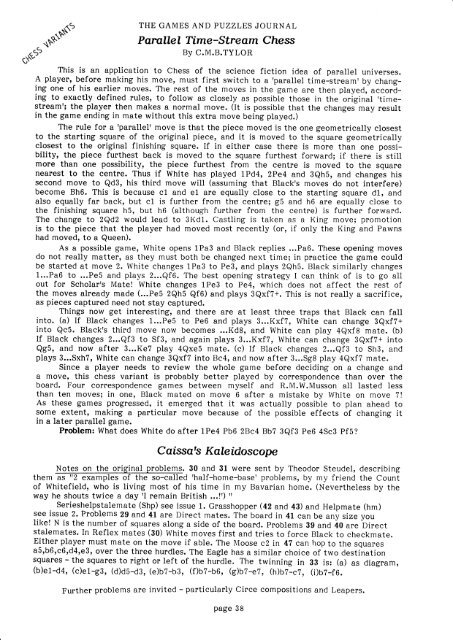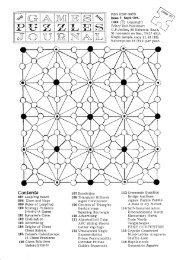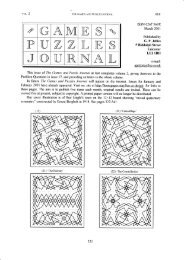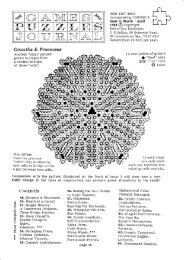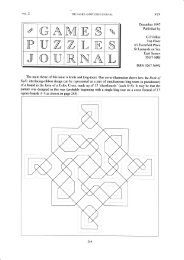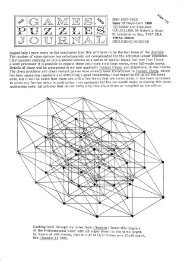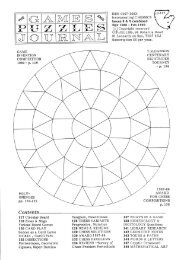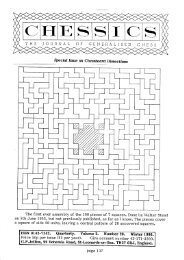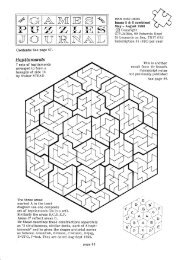The Games and Puzzles Journal, #3 - Mayhematics
The Games and Puzzles Journal, #3 - Mayhematics
The Games and Puzzles Journal, #3 - Mayhematics
- No tags were found...
You also want an ePaper? Increase the reach of your titles
YUMPU automatically turns print PDFs into web optimized ePapers that Google loves.
fd<br />
THE GAMES AND PUZZLES JOURNAL<br />
P orv,llel Ttme - Str e om Che&s<br />
By C.M.B.TYLOR<br />
"sF' This is an application to Chess of the science fiction idea of parallel universes.<br />
A player,, before making his move, must first switch to a 'parallel time-stream, by changing<br />
one of his earlier moves. <strong>The</strong> rest of the moves in the game are then played, accorling<br />
to exactly defined rules, to follow as closely as possible those in the original 'timestreamr;<br />
the player then makes a normal move. (It is possible that the changes may result<br />
in the game ending in mate without this extra move being played.)<br />
<strong>The</strong> rule for a tparallel' move is that the pieee moved is the one geometrically closest<br />
to the starting square of the original piece, <strong>and</strong> it is moved to the square geometrically<br />
closest to the original finishing square. If in either ease there is more than one possibility,<br />
the piece furthest back is moved to the square furthest forward; if there is still<br />
more than one possibility, the piece furthest from the centre is moved to the square<br />
nearest to the centre. Thus if White has played 1Pd4, 2Pe4 <strong>and</strong> 3Qh5, <strong>and</strong> changes his<br />
second move to Qd3, his third move will (assuming that Black's moves do not interfere)<br />
become Bh6. This is because c1 <strong>and</strong> el are equally close to the starting square d1, <strong>and</strong><br />
also equally far back, but cl is further from the centre; g5 <strong>and</strong> h6 are equatly close to<br />
the finishing square h5, but h6 (although further from the centre) is further forward.<br />
<strong>The</strong> change to 2Qd2 would lead to 3Kd1. Castling is taken as a King move; promotion<br />
is to the piece that the player had moved most recently (or, if only the King <strong>and</strong> Pawns<br />
had moved, to a Queen).<br />
As a possible game, White opens 1Pa3 <strong>and</strong> Black replies ...Pa6. <strong>The</strong>se opening moves<br />
do not really matter, as they must both be changed next time; in practice the game could<br />
be started at move 2. White changes 1Pa3 to Pe3, <strong>and</strong> plays 2Qh5. Black similarly changes<br />
L...Pa6 to ...Pe5 <strong>and</strong> plays 2...Qf6. <strong>The</strong> best opening strategy I can think of is to go all<br />
out for Scholar's Mate! White changes 1Pe3 to Pe4, which does not affeet the rest of<br />
the moves already made (...peS 2Qh5 Qf6) <strong>and</strong> plays 3Qxf+. This is not really a sacrifice,<br />
as pieces captured need not stay captured.<br />
Things now get interesting, <strong>and</strong> there are at least three traps that Black can fall<br />
into. (a) If Black changes 1...Pe5 to Pe6 <strong>and</strong> plays 3...Kxf, White can change 3Qxf+<br />
into Qc5. Black's third move now becomes ...Kd8, <strong>and</strong> White can play 4Qxf8 mate. (b)<br />
If Black changes 2...Qf3 to Sf3, <strong>and</strong> again ptays 3...Kxf, White can change 3Qxf+ into<br />
QgS, <strong>and</strong> now after 3...Ke7 play 4Qxeb mate. (c) tf Black changes 2...Qf3 to Sh3, <strong>and</strong><br />
plays 3...Sxh, White can change 3Qxf7 into Bc4, <strong>and</strong> now after 3...Sg8 play 4Qxf7 mate.<br />
Since a player needs to review the whole game before deciding on a change <strong>and</strong><br />
a move, this chess variant is probably better played by correspondence than over the<br />
board. Four correspondence games between myself <strong>and</strong> R.M.W.Musson all lasted less<br />
than ten moves; in one, Black mated on move 6 after a mistake by White on move !<br />
As these games progressed, it emerged that it was actually possible to plan ahead to<br />
some extent' making a particular move because of the possible effects of changing it<br />
in a later parallel game.<br />
Problem: What does White do after 1Pe4 PbO 2Bc4 Bb7 3Qf3 PeG 4Sc3 Pf 5<br />
Carsscts Kaleidoscope<br />
Notes on the orrg.inal_problems.30 <strong>and</strong> 3l were sent by <strong>The</strong>odor Steudel, describing<br />
tnemd'half-home-base'probiems,bymyfriendtheCoun1<br />
of Whitefield, who is Iiving most of his time in my Bavarian home. (Nevertheless by the<br />
way he shouts twice a day 'I remain British ...!') "<br />
Serieshelpstalemate (Shp) see issue L. Grasshopper (42 <strong>and</strong> 43) <strong>and</strong> Helpmate (hm)<br />
see issue 2. Prciblems 29 <strong>and</strong> 4l are Direct mates. fne boarO in 41 can Ue any size you<br />
like! N is the number of squares along a side of the board. Problems Bg <strong>and</strong> 40 are Direct<br />
stalemates. In Reflex mates (30) White moves first <strong>and</strong> tries to force Black to checkmate.<br />
Either player must mate on the move if able. <strong>The</strong> Moose c2 in 47 can hop to the squares<br />
a5'b6rc6,d4,e3, over the three hurdles. <strong>The</strong> Eagle has a similar choice of two destination<br />
sguares - the squares to right or left of the hurdle. <strong>The</strong> twinning in 38 is: (a) as diagram,<br />
(b)e1-d4, (c)e1-g3, (d)ds-d3, (e)uz-ul, (f)b-b6, (g)uz-ez, (n)uz-cz, (i)b-f6.<br />
Further problems are invited - particularly Circe compositions <strong>and</strong> Leapers.<br />
page 38


